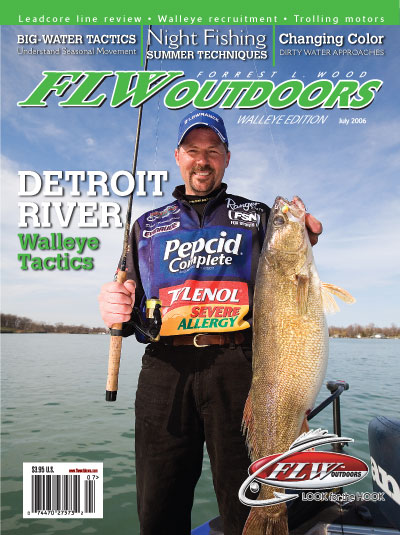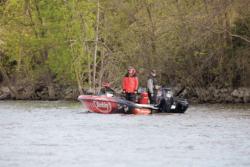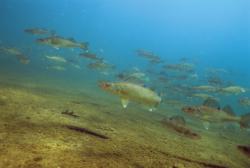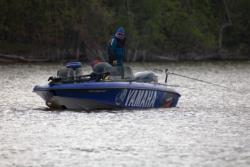Trollin’ on the river
Go-between crankbait tactics

Given their druthers, most river walleye anglers opt for using a jig most of the time. They usually tip it with a minnow, yet on occasion might not – just to show how versatile they are.
Face it: when it comes to river walleyes, jigging current breaks and deep holes is about as ingrained as it gets. Yet despite jigging’s effectiveness, it’s not the be-all and end-all of river presentations. We’re not just talking about occasional experiments with bladebaits, jigging spoons and three-way rigs, either. This time around the subject is crankbaits, which deserve a significant place in your river walleye arsenal, all year long – even in cold water.
Coverage
Where jigging tends to provide finesse and subtle temptation in specific spots, crankbaits enable coverage of wider areas and often trigger walleyes into striking, not just biting. With cranks, increased speed comes into play and, along with it, enhanced sound, vibration and action. Walleyes see jigs approaching out of the murk at the moment of truth but feel and hear cranks coming at longer distances – well before they actually become visible in dark or dingy water. So don’t worry about fish not being able to react quickly enough to nail a passing lure. Just look at how they routinely whack crankbaits in the mud fest of the Detroit River each spring when the water’s too murky to locate jigs. If they want it, they’ll get it just fine.
 The upgrade from drifting speed to trolling velocity adds new dimensions to your fishing strategy. To begin with, no longer must you focus strictly on obvious fish-attracting areas like holes at river bends. Now you can afford to invest a little time fishing the intervening stretches between them should they appear to have fish potential. There’s no better time to do this than when fish are migrating, with schools likely to be in transit between holding areas.
The upgrade from drifting speed to trolling velocity adds new dimensions to your fishing strategy. To begin with, no longer must you focus strictly on obvious fish-attracting areas like holes at river bends. Now you can afford to invest a little time fishing the intervening stretches between them should they appear to have fish potential. There’s no better time to do this than when fish are migrating, with schools likely to be in transit between holding areas.
Spring and fall are likely candidates for this behavior. Both seasons feature cool to cold water, yet there are subtle differences between them. In early spring, the water often tends to be high, or at least rising, with fish moving upstream to spawn. After spawning concludes, however, the fish typically begin dispersing downstream toward their eventual summer habitat. So they’re both coming and going in reasonably high water.
In fall, the water is usually lower and likely even falling. In some cases, walleyes will be moving upstream to hold in holes. In others, they’ll be deserting shallow stretches for the safety of deep water and forced to move downstream to the deeper ends of small reservoirs. So they could be either coming or going – although usually not both – in lower water conditions than they experience in spring.
Lying between these seasons is the warm water of summer, when river walleyes tend to hold in areas of modest depth and decent current flow providing good oxygen levels. In small, shallow rivers, holes are the obvious attractors. In bigger rivers, intervening 6- to 8-foot stretches between holes have loads of potential. So in one case, you troll the holes themselves. In the other, the moderate-depth stretches between holes may be better fish attractors. The nice thing is there’s a place for cranks in all of them.
Go-between
Higher-water springtime conditions are perfect for long-line trolling tactics incorporating a medium-power casting rod and FireLine for enhanced sensitivity. Handhold the rod and you’ll feel every wiggle of the vibration, every tick of the lure against bottom, every fragment of weed that might diminish lure action. Troll slowly upstream, just enough to make headway against the flow. Pump and drop the rod occasionally, imparting an irregular surge and pause to help trigger strikes. Hover at times in areas where you see fish near bottom on your electronics, allowing your lure to dance in front of their noses.
Spring is spawning time for shiners, shad and other species also migrating upstream, making lures that resemble these baitfish prime candidates for success. Rapala Deep Husky Jerks, Smithwick Deep Rogues, Storm Deep ThunderSticks, Reef Runner Deep Divers, Bomber 25 As, Matzuo Prism Shads, etc., mimic slender profiles and provide a subtle rolling wiggle that produces strikes in cold water. If shad are on the menu, stick more with Rapala Glass Shad Raps, Cordell Grappler Shads or other shad imitators. In all cases, the trick is to let out just enough line for your lure to scrabble and scramble across the basin occasionally, but avoid snagging.
Deeper-diving minnow imitators should have no difficulty reaching the 10- to 15-foot levels, and are perfect for larger rivers like the Rainy, Saginaw or other fairly large rivers with long expanses of moderately deep water between holes. If the rivers you fish are significantly shallower, switch to lures that don’t dive as deeply, rather than simply shortening your line; you still want 75 feet or more of line between your lure and the boat to minimize spooking associated with the outboard.
When spawning concludes and fish begin moving downstream, the same tactics still apply. With the water growing warmer (above 50 degrees), however, you now have the option to apply a bit more speed to your presentation. It may be that trolling downcurrent produces as well as moving upstream. This necessitates increasing motor speed to first overcome the current and then to start the bait wiggling. Since your boat’s moving downstream with the flow, it may seem that the shoreline is screaming by at warp speed. Don’t worry about it. Just speed up to the point that you feel your bait wiggling and go for it.
Hauling hole
 Lower-water conditions beginning in midsummer and extending into fall host a combination of fish holding in holes and migratory fish moving up- or downcurrent. The water’s also usually clearer and the depth shallower compared to spring conditions.
Lower-water conditions beginning in midsummer and extending into fall host a combination of fish holding in holes and migratory fish moving up- or downcurrent. The water’s also usually clearer and the depth shallower compared to spring conditions.
This situation encourages the use of slightly shallower-running lures and selection of crankbaits with an enhanced wobble and action. Crayfish are on the prowl in summer, providing significant forage for both walleyes and smallmouth bass, bolstering the natural forage selection. So in addition to experimenting with cranks that imitate slender minnows or shad, be sure to try rounder-bodied, aggressive wobblers like Rapala’s Fat Rap and Shad Rap RS, Storm Thunder Pros and Wiggle Warts, Bomber 4 through 8As, Rebel Wee and Deep Wee Rs, Cordell Wiggle `O’s, etc., that resemble crayfish profiles.
Select a lure that dives deep enough to tick bottom, often in as little as 6 to 8 feet of water since the river is shallower at this time of year. These lures also provide good options to stop and cast around rock points, wing dams or riprap areas that deflect current – good summer walleye producers. The more rocks you whack, the more plastic lures are favored for durability, as opposed to the subtler wiggle of balsa construction.
“The shallow Upper Mississippi in central and northern Minnesota offers superb smallmouth bass fishing,” said James Lindner of Lindner’s Angling Edge TV, “plus loads of smaller walleyes along with the occasional biggie. We fish the river pretty hard all summer with just about every technique imaginable, and do you know what we catch the biggest walleyes on? Crankbaits. In fact, the big ones over 6 pounds usually are bonus fish caught while casting or trolling for smallmouths. You catch smaller walleyes on live bait in summer, but the big ‘eyes hit cranks.”
With the intervening stretches between holes shallower in late summer and fall than they are in spring, in-between areas may be better candidates for quick checks, rather than spending significant time in them – particularly in small rivers. In all probability, you want to focus on holes formed at river bends, constrictions, below bridges or anywhere the river suddenly becomes 3 or 4 feet deeper – sometimes more. Then it’s simply a matter of trolling upstream and downstream through the basins of the holes, once again adjusting the throttle to make your bait wiggle appropriately. Going upstream, you barely need to make headway. Moving downstream, you must move fast enough to overtake the current and get the bait wobbling.
Shallow-river holes are bound to contain nasty wood snags, but that’s a part of the program you can’t ignore. When you snag, move the boat upstream of the location, try to pull the lure off, or try using a lure retriever to get the bait back. Once you determine where the prominent snags are, try to skirt their edges. But be aware that you must fish where the fish are, even if it’s around wood. It’s nice when active walleyes lie near the head of a hole, or less active ones are scattered across a clean, snag-free basin. But when wood is a factor, toughen up. Bend your hook points inward slightly to reduce snags. Perhaps even clip off the lower tines of your trebles with a pair of pliers. Do whatever it takes to be effective.
 By mid- to late fall, significant numbers of walleyes may begin moving downstream into the deeper reservoir portions of small rivers. Try focusing your efforts near points, humps or channel bends within these areas. Trolling crankbaits finds them in short order.
By mid- to late fall, significant numbers of walleyes may begin moving downstream into the deeper reservoir portions of small rivers. Try focusing your efforts near points, humps or channel bends within these areas. Trolling crankbaits finds them in short order.
In the event the impoundment section is broad and offers a significant basin, consider using lead-core lines and trolling boards to spread an array of lures behind the boat, and troll the basin just as you would in a lake. Lake Pepin on the Upper Mississippi is one such example where a mixed bag of walleyes and saugers are possible with this technique. Saugers, in particular, like their lures down and dirty, meaning pounding the mud basin and kicking up a ruckus.
When you consider that three of the top five places in last fall’s Wal-Mart FLW Walleye Tour Championship on the Mississippi River at the Quad Cities were claimed by crankbait trollers, it lends further credence to their use on rivers. Shannon Kehl finished second trolling with FireLine and No. 7 Shad Raps; Kevin Goligowski cast Bomber 6As and a Shad Rap RS, plus trolled Cordell Wally Divers and No. 5 Shad Raps on lead core for third; and Carl Grunwaldt trolled lead core, taking fifth on No. 5 Shad Raps. Even fourth-place finisher Jarrad Fluekiger caught some of his fish casting Bomber Fat Free Shads across wing dams. So in the pro ranks, at least, there’s no reluctance to using hard baits for river ‘eyes.
Among recreational anglers, however, crankbaits will likely never replace jigs as the number one go-to tactic for river walleyes. Jigs are too firmly entrenched in the prevailing psyche. But you must admit they do provide an additional option for when you need a little get-up-and-go to find and catch ’em. When walleyes are migrating between holes in spring and fall, hunt them down with a long-line troll. When they’re holding in the basins of holes in midsummer and you need additional speed and vibration to get their attention amidst a host of forage, plow the basins of holes up- and downcurrent, stirring things up. And when faced with shallow reservoir basins with negligible current, consider a lead-core application to hug bottom and eliminate unproductive water until you locate the bulk of the fish.
The nice thing is, once you find them, be it in a hole, between holes or even lying across a basin, you can always put down your trolling rod and pick up a jigging rod. After all, old habits are tough to break.